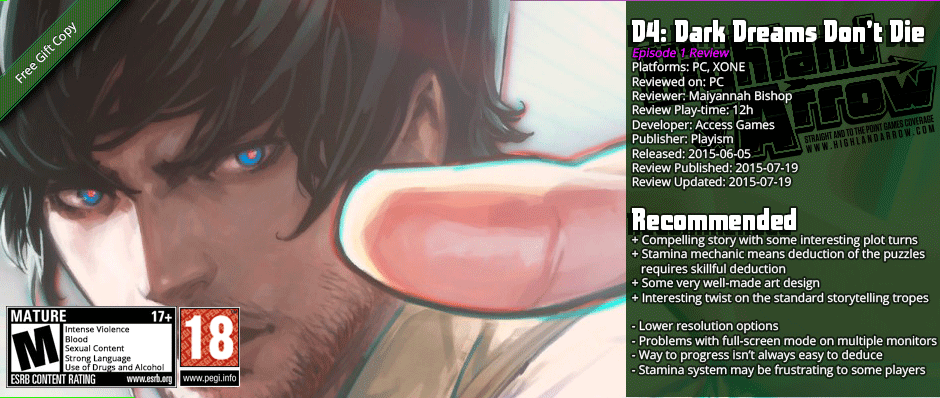

Editor's Note: D4 is an episodic game, and this is a review of the first episode, which is the one currently-available on PC at time of writing. Maiyannah's copy of this game was provided free of charge by a reader.
D4: Dark Dreams Don't Die is an episodic adventure game developed by enigmatic Japanese designer Swery65 and his studio Access Games, with publishing on PC provided by Playism. I have to admit some bias towards Swery65, because while the games he has made may not always be the most revolutionary game designs, he always makes something at least interesting - and I'll be damned if D4 doesn't fit that bill quite certainly. It's not perfect and has some issues, but I quite enjoyed my time with D4's first episode.
The port suffers from some strange engine issues
One of the first things I noticed about the PC port of D4 is that the resolutions offered in its launcher are quite lacking, with 1440x900 being the maximum it offered me and 720p being the default. Hardly a game-breaker of course, but it is odd in this day and age, when we're breaking 4k resolutions at this point. There's some other issues as well, nothing at all game-breaking or even that big but odd all the same, such as the fact that in my first playthrough I didn't get any of the achievements for the game. I can take or leave achievements anyways, but no doubt there's some of you out there to whom that is important.
Graphically it does the sort of shader trick where edges get outlined in black to create a sort of comic book or magna look. Having seen it on both PC and on the console from which it came, I can say it looks better there, for whatever reason, but it's not a bad look regardless. What really stands out here though is the lack of anti-aliasing, with jaggies everywheres. Not entirely to be unexpected given it's a console port, but it's a stubborn holdout of console games to have such a basic feature missing.
D4 has a pretty intriguing story
I won't get into the story into too much depth here since I want to avoid spoilers, but I found the plot on offer in D4 pretty compelling, and it's most of what saw me through the game to completion. It has a lot of interesting twists and turns, and just when you think you've figured everything out it'll put a new curve into things. Told through a series of interactions and attached film noir-style exposition dumps, it never really dumps you to cutscene or the like either, you're always at least somewhat in the action, and I have to admit it's use of quick-time events to this end is fairly apt.
The character writing is the big strong point here, with each of them having very "wacky" appearances at first - which is part of the twist here, really. I won't spoil it in it's fullness, but the general thing going here is that your character David has ahead injury from the attack that he is investigating, and so the lines between reality and delusion become blurred. This is an idea that the game plays on masterfully in places, and while you might think you'll see some of the story turns coming, they're always at least a little off what I thought they'd be. In short, it plays on what you think and would expect. It knows you expect certain twists, and it uses that knowledge to play off things.
The gameplay elements are fairly generic however
The game basically comes down to clicking things. Whether it be during cutscenes for additional information with little quick time events, or the more traditional point-and-click adventure fare, it's a very basic gameplay model. D4 is very much a game that uses the gameplay to move the plot, where it's very much in service to that narrative, but in D4's credit, it works fairly well without feeling like it obstructs the progression or seems out of place. If you've played a point-and-click adventure before most of the verbs at play here are familiar, and you're not going to be too out of your element.
What does obstruct the gameplay sometimes is the game's lack of direction. While I would usually praise a game for not holding a player's hand like a creepy uncle the whole way through, in D4's case it seems somewhat to the detriment of the game since the game does not well signpost what you have to do sometimes. There's an over-arching objective given in each of the various areas, but given the surrealist story-telling at points, the means by which you get there is often fairly obscured. That's not to say the puzzles are particularly complex if you're used to adventure-game logic (as I am from many a Sierra adventure game), but if you're simply trying to follow the logical trail you're going to hit a few dead ends.
The way that D4 adds something different is a dwindling stamina meter. Basically, this boils down to the fact that you have a certain amount of "actions" in which to determine the puzzle, which rewards players for being expedient in getting between the different places. You can stockpile food items to replenish the stamina meter, but you'll want to be somewhat tight-fisted with them, because there are som puzzles you'll want them for. I rather liked that though, because most adventure games suffer from the fact that you can essentially "brute force" your way through them eventually, whereas having that mechanic means that this isn't a viable option in D4 and you have to sit down and really pay attention and figure things out.
Other innovation, if it can be followed that, is in the movement-based QTEs. They're mostly a holdover from the console version, where the X-Box version had the seemingly-mandatory Kinect stuff. It was optional even there, which made them seem all the odder. I guess the developers figured as I did, which is to say that they're awkward at best and not going to be to everyone's tastes, to say the very most. It's a bit of a pass when it comes to mechanics, but I never found them so intrusive as to break the game flow or immersion, more just awkward than anything.


